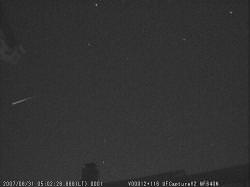Monday, September 2 – Tonight we’ll hunt with the “Fox” as we head to Vulpecula to try two more open star cluster studies. The first can be done easily with large binoculars or a low power scope. It’s a rich beauty that lies in the constellation of Vulpecula, but is more easily found by moving around 3 degrees southeast of Beta Cygni.
Known as Stock 1, this stellar swarm contains around 50 or so members of varying magnitudes that you will return to often. With a visual magnitude of near 5, loose associations of stars – like Stock clusters – are the subject of recent research. The latest information indicates that the members of this cluster are truly associated with one another.
A little more than a degree to the northeast is NGC 6815. While this slightly more compressed open cluster has no real status amongst deep sky objects, it is another one to add to your collection of things to do and see!
Tuesday, September 3 – Tonight we’ll start with an asterism known as the “Coat Hanger,” but it is also known as Brocchi’s Cluster, or Collinder 399. Let the colorful double star Beta Cygni – Albireo – be your guide as you move about 4 degrees to its south-southwest. You will know this cluster when you see it, because it really does look like a coat hanger! Enjoy its red stars.
First discovered by Al Sufi in 964 AD, this 3.5 magnitude collection of stars was again recorded by Hodierna. Thanks to its expansive size of more than 60 arc minutes, it escaped the catalogues of both Messier and Herschel. Only around a half dozen stars share the same proper motion, which may make it a cluster much like the Pleiades, but studies suggest it is merely an asterism…but one with two binary stars at its heart.
And for larger scopes? Fade east to the last prominent star in the cluster and power up. NGC 6802 awaits you! At near magnitude 9, Herschel VI.14 is a well compressed open cluster of faint members. The subject of ongoing research in stellar evolution, this 100,000 year old cluster is on many observing challenge lists!
Wednesday, September 4 – Twenty-four hours ago in 1976, the Viking 2 lander successfully touched down on Mars. If you’ve been waiting on your opportunity to see the Red Planet again, you’ll find it 5.8 degrees south of the Moon as the new day begins.
Tonight we’ll start with the brightest star in Vulpecula – Alpha. Although it is not a true binary star, it is quite attractive in the telescope and an easy split for binoculars. Alpha itself is a 4.4 magnitude red giant which makes a nice color contrast with the unrelated yellow field star which is two magnitudes dimmer.
Now head around one half degree northwest for open cluster NGC 6800. Also known as Herschel VIII.21, this cluster is suitable for even smaller scopes but requires aperture to resolve completely. Discovered by Sir William in this month (10th) in 1784, you’ll like this ring-like arrangement of stars!
Now drop 2.7 degrees southwest of Alpha for yet another open cluster – NGC 6793. Discovered by Herschel in 1789 and logged as catalog object VIII.81, you’ll find a few more bright stars here. The challenge in this cluster is not so much being able to see it in a smaller telescope – but being able to discern a cluster from a starfield!
Thursday, September 5 – Tonight we’ll return again to Vulpecula – but with a different goal in mind. What we’re after requires dark skies – but can be seen in both binoculars and a small telescope. Once you’ve found Alpha, begin about two fingerwidths southeast and right on the galactic equator you’ll find NGC 6823.
The first thing you will note is a fairly large, somewhat concentrated magnitude 7 open cluster. Resolved in larger telescopes, the viewer may note these stars are the hot, blue/white variety. For good reason. NGC 6823 only formed about 2 billion years ago. Although it is some 6000 light-years away and occupies around 50 light-years of space, it’s sharing the field with something more – a very large emission/reflection nebula, NGC 6820.
In the outer reaches of the star cluster, new stars are being formed in masses of gas and dust as hot radiation is shed from the brightest of the stellar members of this pair. Fueled by emission, NGC 6820 isn’t always an easy visual object – it is faint and covers almost four times as much area as the cluster. But trace the edges very carefully, since the borders are much more illuminated than the region of the central cluster. Take the time to really observe this one! Its processes are very much like those of the “Trapezium” area in the Orion nebula.
Be sure to mark your observing notes. NGC 6823 is Herschel VII.18 and NGC 6820 is also known as Marth 401!
Friday, September 6 – Today celebrates the founding of the Astronomical and Astrophysical Society of America. Started in 1899, it is now known as the American Astronomical Society.
Tonight we are going to take a journey once again toward an area which has intrigued this author since I first laid eyes on it with a telescope. Some think it difficult to find, but there is a very simple trick. Look for the primary stars of Sagitta just to the west of bright Albireo. Make note of the distance between the two brightest and look exactly that distance north of the “tip of the arrow” and you’ll find M27.
Discovered in 1764 by Messier in a 3.5 foot focal length telescope, I discovered this 48,000 year old planetary nebula for the first time in a 4″ telescope. I was hooked immediately. Here before my eager eyes was a glowing green “apple core” which had a quality about it that I did not understand. It somehow moved… It pulsated. It appeared “living.”
For many years I quested to understand the 850 light-year distant M27, but no one could answer my questions. I researched and learned it was made up of doubly ionized oxygen. I had hoped that perhaps there was a spectral reason to what I viewed year after year – but still no answer. Like all amateurs, I became the victim of “aperture fever” and I continued to study M27 with a 12″ telescope, never realizing the answer was right there – I just hadn’t powered up enough.
Several years later while studying at the Observatory, I was viewing through a friend’s identical 12″ telescope and, as chance would have it, he was using about twice the magnification that I normally used on the “Dumbbell.” Imagine my total astonishment as I realized for the very first time that the faint central star had an even fainter companion that made it seem to wink! At smaller apertures or low power, this was not revealed. Still, the eye could “see” a movement within the nebula – the central, radiating star and its companion.
Do not sell the Dumbbell short. It can be seen as a small, unresolved area in common binoculars, easily picked out with larger binoculars as an irregular planetary nebula, and turns astounding with even the smallest of telescopes. In the words of Burnham, “The observer who spends a few moments in quiet contemplation of this nebula will be made aware of direct contact with cosmic things; even the radiation reaching us from the celestial depths is of a type unknown on Earth…”
Saturday, September 7 – When skies are dark, it’s time for us to head directly between the two southernmost stars in the constellation of Lyra and grab the “Ring.” What summer would be complete without it?
First discovered by French astronomer Antoine Darquier in 1779, the Ring Nebula was cataloged later that year by Charles Messier as M57. In binoculars the Ring will appear as slightly larger than a star, yet it cannot be focused to a sharp point. To a modest telescope at even low power, M57 turns into a glowing donut against a wonderful stellar backdrop. The average accepted distance to this unusual structure is 1,400 light-years, and how you see the Ring on any given night is mostly attributable to conditions. As aperture and power increase, so do details, and it is not impossible to see braiding in the nebula’s structure with scopes as small as eight inches on a fine night, or to pick up the star caught on the edge in even smaller apertures.
Like all planetary nebulae, seeing the central star is considered the ultimate of viewing. The central itself is a peculiar bluish dwarf which gives off a continuous spectrum and might very well be a variable. At times, this shy, near 15th magnitude star can be seen with ease with a 12″ telescope, yet be elusive to 31″ in aperture weeks later. No matter what details you may see, reach for the “Ring” tonight. You’ll be glad you did.
Saturday, September 8 – Today in 1966, a legend was born as the television program, “Star Trek” premiered. Created by Gene Roddenberry, it was instrumental in inspiring several generations’ interest in space, astronomy, and technology. The short-running series still airs in repeats, along with many movie and series sequels. May it continue to “live long and prosper.”
As your starry mission this evening, we’ll continue our studies in Vulpecula with a spectacular open cluster – NGC 6940. At close to magnitude 6, you’ll find this unsung symphony of stars around three fingerwidths southwest of Epsilon Cygni (RA 20 34 24.00 Dec +28 17 -0.0).
Discovered by Sir William Herschel on Oct 15, 1784, and logged as H VIII.23, this intermediate aged galactic cluster will blow your mind in larger aperture. Visible in binoculars, as size increases the field explodes into about 100 stars in a highly compressed, rich cloud. Although it is not an often visited cluster, it is part of many observing challenge lists. Use low power to get the full effect of this stunning starfield!
If you see a shooting star while you’re out, it may belong to the Piscid meteor stream which will reach its peak tonight with an expected maximum of around 5 meteors per hour. This particular shower favors the southern hemisphere. While this branch of the Piscids is a rather unstudied, it is an unusual and diffuse stream that is active all month.










